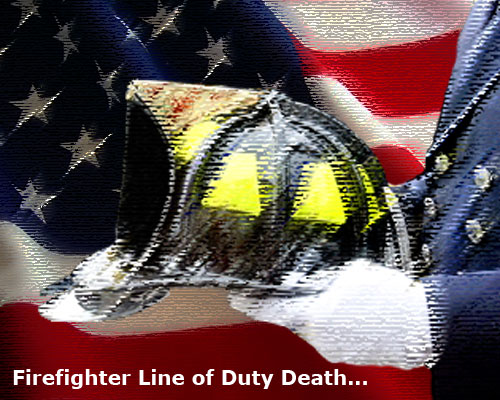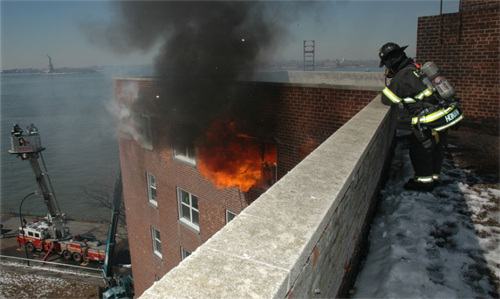Sudden Blast
June 22nd, 2009Unanticipated smoke explosion and building collapse nearly kills three firefighters.
Portsmouth, VA Near-Miss Incident
Firefighter Eric Kirk gives a firsthand account of a near-miss incident involving a smoke explosion in the June 2009 issue of FireRescue magazine. On a December morning in 2007, firefighters in Portsmouth, Virginia responded to a fire in a church. On arrival, the building was well involved and defensive operations were initiated to protect exposures and confine the fire. Over the course of the fire, smoke extended into an attached, three-story, brick building and formed a flammable fuel/air mixture. Subsequent extension of flames from the church to the interior of the exposure resulted in ignition and explosive combustion of this fuel (smoke)/air mixture.
Incident Photos from PilotOnline.com
Smoke Explosion
This post expands on Smoke is Fuel (Hartin, 2009), a sidebar that I wrote for FireRescue that accompanies Eric’s article examining the Portsmouth, VA smoke explosion incident.
Smoke explosions have resulted in three firefighter fatalities in the United States since 2005, two in Wyoming (see NIOSH Report F2005-13) and one last year in Los Angeles California (NIOSH report pending). In addition, there have been a number of near miss incidents including this one in Virginia and another in Durango, Colorado (see NIOSH Report F2008-02)However, many firefighters have not heard of or misunderstand this fire behavior phenomenon.
The terms backdraft and smoke explosion have typically been used to describe explosions resulting results from confined and rapid combustion of pyrolysis and unburnt products of incomplete combustion. Describing a backdraft incident at a Chatham, England Mattress Store in 1975, Croft (1980) states “this is not an entirely new phenomenon, the first formal description of what have been called ‘smoke explosions’ having been given in 1914” (p. 3).
As an explanation of many contradictory statements in reference to explosions that are reported to have occurred in burning buildings, where it is also testified that explosives were non-existent, we may cite so-called “smoke explosions.”
Distinct from, yet closely allied with explosions of inflammable dust, are explosions caused by the ignition of mixtures of air with the minute particles of unconsumed carbon and invisible gaseous matter in smoke from the imperfect combustion of organic substances…
These “smoke explosions” frequently occur in burning buildings and are commonly termed “back draughts” or “hot air explosions” (Steward, 1914).
As discussed in my earlier post, Fires and Explosions, the term Smoke Explosion was a synonym for Backdraft. In fact, if you look up the definition of smoke explosion in the National Fire Protection Association (NFPA) 921 (2008) Guide for Fire and Explosion Investigation, it says “see backdraft” (p. 921-15). However, today it identifies a different, and in many respects more dangerous extreme fire behavior phenomenon. Smoke (or Fire Gas) Explosion is described in fire dynamics textbooks such as Enclosure Fire Dynamics (Karlsson and Quintiere) and An Introduction to Fire Dynamics (Drysdale) and Enclosure Fires (Bengtsson). Of these, the text Enclosure Fires by Swedish Fire Protection Engineer Lars-Göran Bengtsson provides the best explanation of how conditions for a smoke explosion develop. However, this phenomenon is less well known among firefighters and fire officers. In fact many well known fire service authors continue to use backdraft and smoke explosion interchangeably.
A smoke or fire gas explosion occurs when unburned pyrolysis products accumulate and mix with air, forming a flammable mixture and introduction of a source of ignition results in a violent explosion of the pre-mixed fuel gases and air. This phenomenon generally occurs remote from the fire (as in an attached exposure) or after fire control.
Conditions Required for a Smoke Explosion
The risk of a smoke explosion is greatest in compartments or void spaces adjacent to, but not yet involved in fire. Infiltration of smoke through void spaces or other conduits can result in a well mixed volume of smoke (fuel) and air within its flammable range, requiring only a source of ignition.
Smoke explosions create a significant overpressure as the fuel and air are premixed. Several factors influence the violence of this type of explosion:
- The degree of confinement (more confinement results in increased overpressure)
- Mass of premixed fuel and air in the compartment (more premixed fuel results in a larger energy release)
- How close the mixture is to a stoichiometric concentration (the closer to an ideal mixture the faster the deflagration)
For additional information on transient, explosive, fire phenomena see earlier posts: Gas Explosions and Gas Explosions Part 2.
Indicators Smoke Explosion Potential
It is very difficult to predict a smoke explosion. However, the following indicators point to the potential for this phenomenon to occur.
- Ventilation controlled fire (inefficient combustion producing substantial amounts of unburned pyrolysis products and flammable products of incomplete combustion)
- Relatively cool (generally less than 600o C or 1112o F) smoke
- Presence of void spaces, particularly if they are interconnected
- Combustible structural elements
- Infiltration of significant amounts of smoke into uninvolved exposures
Mitigating the Hazard
As with recognizing the potential for a smoke explosion, mitigation can also be difficult. The gases are relatively cool, so application of water into the gas layer may have limited effect. Tactical ventilation to remove the smoke is the only way to fully mitigate the hazard and establish a safe zone. However, use care not to create a source of ignition (such as the sparks created when using an abrasive blade on a rotary saw).
The best course of action is to prevent infiltration of smoke into uninvolved spaces using anti-ventilation (confinement) tactics. Anti-ventilation is the planned and systematic confinement of heat, smoke, and fire gases, and exclusion of fresh air (from the fire). In this case, anti-ventilation may involve pressurizing the uninvolved are to prevent the spread and accumulation of smoke.
Ed Hartin, MS, EFO, MIFIreE, CFO
References
Bengtsson, L. (2001). Enclosure fires. Karlstad, Sweden: Räddnings Verket.
Croft, W. (1980) Fires involving explosions-a literature review. Fire Safety Journal, 3(1), 3-24.
Drysdale, D. (1998). An introduction to fire dynamics (2nd ed.). New York: John Wiley & Sons.
Hartin, E. (2009, June). Smoke is fuel. FireRescue, 27(6), 54.
Karlsson, B. & Quintiere, J. (2000). Enclosure fire dynamics. Boca Raton, LA: CRC Press.
Kirk, E. (2009, June). Sudden blast: Unanticipated smoke explosion & building collapse nearly kills 3 firefighters. FireRescue, 27(6), 52-54.
National Fire Protection Association. (2008). NFPA 921 Guide for fire and explosion investigations. Quincy, MA: Author.
National Institute for Occupational Safety and Health (NIOSH). (2006) Death in the Line of Duty Report F2005-13. Retrieved June 22, 2009 from http://www.cdc.gov/niosh/fire/pdfs/face200513.pdf
National Institute for Occupational Safety and Health (NIOSH). (2009) Death in the Line of Duty Report F2008-02. Retrieved June 22, 2009 from http://www.cdc.gov/niosh/fire/pdfs/face200803.pdf
Steward, P. (1914). Dust and smoke explosions, NFPA Quarterly 7, 424-428.


















